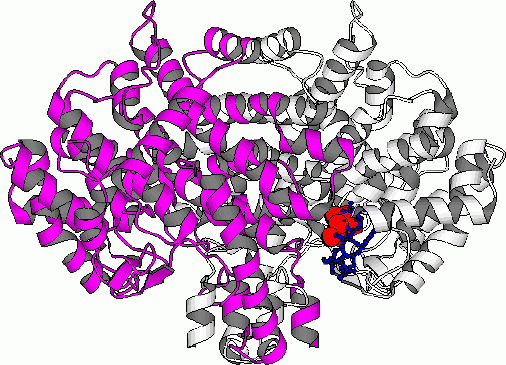Modelling
Biological Molecules and Simulating Enzyme-Catalysed Reactions
Dr.
Adrian Mulholland (Adrian.Mulholland@bris.ac.uk)
Two PhD studentships are available, to start in October 2003. Projects are available in the areas of modelling mechanisms and structures of cytochrome p450 in drug metabolism, quantum effects in enzyme-catalysed reactions, simulation of the mechanisms of medically important mammalian detoxification enzymes, and bioinformatics approaches to relating enzyme sequence, structure and function. Please contact me for more details.
Most biochemical
reactions
depend on enzyme catalysis, and understanding how enzymes 'work' at the
molecular level is a fundamental problem. Enzymes are remarkably
efficient and specific catalysts, but despite intensive experimental investigations,
the detailed origins of their rate accelerations remain unclear.
This question is of crucial importance in biology, and also for the development
of protein catalysts for practical applications. Better understanding
is vital for analysing the activities of mutant or
designed proteins, and for the design of inhibitors
as pharmaceutical lead compounds.
 Citrate
synthase (refs.1,4&8)
Citrate
synthase (refs.1,4&8)
Computer
simulations are a good way to study enzyme reactions. They
can provide information which is often inaccessible experimentally, such
as details of unstable species (for example transition states and reaction
intermediates) and on energetic contributions to catalysis. Simulating
an enzyme reaction is a challenging problem, and requires the use of specialized
techniques. An effective approach is to use combined
quantum mechanical/molecular mechanical (QM/MM)
methods. Molecular mechanics methods can be used to study
protein conformational changes, dynamics and binding, but generally they
can't be applied to processes involving the breaking or making of chemical
bonds. For chemical reactions a quantum mechanical description is
needed, which can be achieved by the combined QM/MM approach. The
small QM region contains the groups involved in the reaction (e.g. the
catalytic residues and the substrate(s)) and is influenced by the surroundings
(represented more simply by standard molecular mechanics), so including
the effects of the environment. In this way the reaction in an enzyme
can be studied, and contributions of individual groups can be analysed.
The central theme of my work
is the use of simulation methods to investigate enzyme mechanism and dynamics
(in several cases in active collaboration with experimental studies).
Programming expertise is not required for most of the present work. Projects
offered include:
-
Mechanisms of glycosidases. Specific
hydrolysis of glycosidic bonds of carbohydrates is required for a wide
variety of metabolic processes, and is catalysed by an important family
of enzymes, the glycosidases. Simulations are being used to investigate
substrate binding, and unresolved mechanistic questions, using structures
of enzyme-inhibitor complexes.
-
Aspartate beta semi-aldehyde dehydrogenase (ASADH) is a bacterial biosynthetic
enzyme, and a target for the development of anti-bacterial
agents. We are examining the mechanism of ASADH and inhibitor
binding in collaboration with Dr.
Andrea Hadfield of the Dept.
of Biochemistry, who is studying the enzyme by X-ray crystallography.
-
We are working to understand differences in activity and stability between
normal enzymes and those isolated from ‘thermophiles’
(organisms which thrive at high temperature). Study of the dynamics
and mechanisms of these enzymes will help elucidate the adaptations responsible
for these differences, with important implications for the design of stable,
active protein catalysts for practical synthetic and biotechnological applications
(in collaboration with experimental work at the Centre
for Extremophile Research, University of Bath).
-
Other work includes studies of biological ligand
binding, solvation and electronic effects in catalysis, and method
development for the study of enzyme reaction dynamics.
Some references (please contact me if you would
like reprints):
-
A.J. Mulholland, P.D. Lyne and M. Karplus, Ab Initio QM/MM Study of the
Citrate Synthase Mechanism. A Low-Barrier Hydrogen Bond is not
Involved J. Am. Chem. Soc.
122, 534-535 (2000)
-
A.T. Hadfield and A.J. Mulholland, Active Site Dynamics of ASADH-
A Bacterial Biosynthetic Enzyme Int. J. Quant. Chem.,
Biophys. Q. 73, 137-146 (1999)
-
L. Ridder, A.J. Mulholland, J. Vervoort and I.M.C.M. Rietjens, Correlation
of Calculated Activation Energies with Experimental Rate Constants for an
Enzyme-Catalyzed Aromatic Hydroxylation J. Am. Chem. Soc.
120, 7641-7642 (1998)
-
A.J. Mulholland and W.G. Richards, Modeling Enzyme Reaction Intermediates
and Transition States: Citrate Synthase J.Phys.Chem. B
102, 6635-6646 (1998)
-
A.J. Mulholland, G.H. Grant and W.G. Richards, Review: Computer modelling
of enzyme catalysed reaction mechanisms. Protein Engineering
6, 133-147 (1993)
-
P.D. Lyne, A.J. Mulholland and W.G. Richards, Insights into Chorismate
Mutase Catalysis from a Combined QM/MM Simulation of the Enzyme Reaction.
J. Am. Chem. Soc. 117, 11345-11350 (1995)
-
A.J. Mulholland and M. Karplus, Simulations of enzymic reactions,
Biochem. Soc. Trans. 24, 247-254 (1996)
-
A.J. Mulholland and W.G. Richards, Acetyl-CoA Enolization in Citrate
Synthase: A Quantum Mechanical/Molecular Mechanical (QM/MM) Study,
Proteins: Structure, Function, and Genetics 27, 9-25 (1997)
-
L.Ridder, A.J. Mulholland, I.M.C.M. Rietjens and J. Vervoort, A Quantum Mechanical/Molecular Mechanical Study of the Hydroxylation of Phenol and Halogenated Derivatives by Phenol Hydroxylase,
J. Am. Chem. Soc. 122, 8728-8738 (2000)
 Back to School
of Chemistry Home Page
Back to School
of Chemistry Home Page
 Citrate
synthase (refs.1,4&8)
Citrate
synthase (refs.1,4&8)
 Citrate
synthase (refs.1,4&8)
Citrate
synthase (refs.1,4&8)
 Back to School
of Chemistry Home Page
Back to School
of Chemistry Home Page